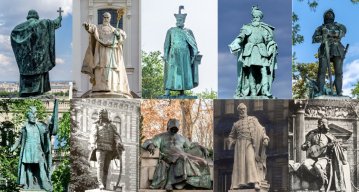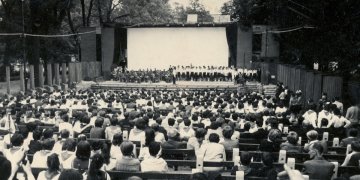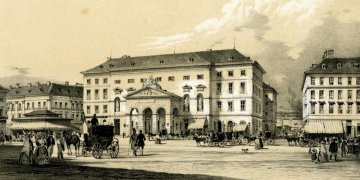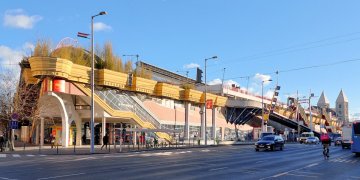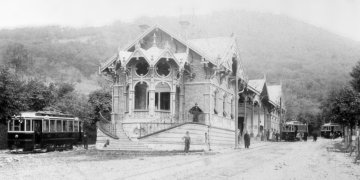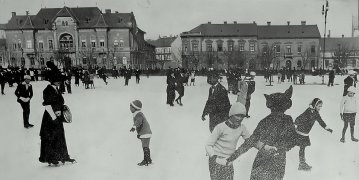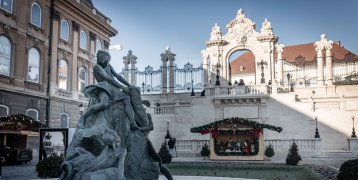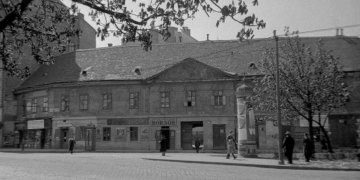Gergely Földváry
Cikkek
The gift of the King: the legend of the ten statues
September 25, 2022 at 3:30 PM
It has been 125 years since Franz Joseph gave ten statues to Budapest on 25 September 1897. Most of the statues are still elegant decorations of the city to this day, and Pestbuda reported about them several times. However, we have now looked into what could have prompted Franz Joseph to give a gift.
Lajos Kossuth's first public statue in Budapest - Special creation in the Zugliget Forest
September 21, 2022 at 11:00 AM
Few people know that at the end of Mátyás Király Road in Zugliget, in the forest, there is a special, 110-year-old statue of Kossuth on a huge pedestal. On the 220th anniversary of the former reformist politician's birth, Pestbuda will show the exact circumstances under which the work of art ended up in the Zugliget Forest, and also examine whether this was really the first public Kossuth Statue in Budapest.
The predecessor of Open-Air Stage: The Park cinema opened a 100 years ago in Városmajor
September 14, 2022 at 5:00 PM
Over the past hundred years, a lot has changed in Városmajor, but culture and guaranteed entertainment have always been present and can still be found in the capital's first public park. The predecessor of the Városmajor Open-Air Stage, the open-air Park cinema, opened here more than a hundred years ago, but the fate of the park was also very interesting after that. In 1935, the well-known stage was built, which, along with its surroundings, has undergone continuous transformations over the past century, including recent times.
Hebe's Kiosk: the first outdoor ice cream parlour in Pest
July 7, 2022 at 1:00 PM
Budapest has a long tradition of making ice cream. Already during the Turkish rule, eastern vendors made iced drinks from fruit juices, and then northern Italian immigrants started making ice cream-like sweets in Buda and Pest in the 18th century. However, the real triumph of today's ice cream can be linked to the name of confectioner Péter Fischer in Budapest, who opened his famous kiosk on today's Vörösmarty Square 180 years ago.
Hundred thousand people at the opening, millions at the exhibition - The House of Terror Museum opened 20 years ago
February 24, 2022 at 11:00 AM
20 years ago, on the eve of Memorial Day for the Victims of Communism, the House of Terror, the former Arrow Cross and then Communist torture house, opened at 60 Andrássy Avenue. The interest was huge, almost a hundred thousand people appeared at the opening to get acquainted with two terrible periods of Hungarian history.
It was the largest indoor sports facility in Hungary but it burned down - The Budapest Sports Hall was handed over 40 years ago
February 12, 2022 at 9:00 AM
Forty years ago, the largest indoor sports hall in Hungary at that time, the Budapest Sports Hall with 12,000 seats, was handed over to the public. The huge building hosted world competitions in many sports, but many Hungarian and world-famous foreign bands and performers, such as Iron Maiden, Metallica, Deep Purple, Elton John and Tina Turner, also performed here. The building was completely burned down in 1999, demolished and replaced by the Papp László Sports Arena.
The Lehel Market Hall building was handed over 20 years ago
February 8, 2022 at 9:30 AM
The Lehel Market Hall building was handed over twenty years ago on the site of the more than 100-year-old Lehel Square Market. The view of the huge five-story hall, which includes more than three hundred business premises, is still very divisive. Thousands of people shop every day in the hall built in the postmodern style. How could it be that even though they wanted to design a hall here as early as the 1900s, they had to wait until the 2000s? That is what PestBuda investigated.
The legendary Zugliget tram line was shut down 45 years ago
January 17, 2022 at 2:00 PM
One of the most popular tram lines, the last of which was the iconic tram 58, was discontinued 45 years ago, on 17 January 1977. One of the first tram lines on the Buda side was the one in Zugliget, which started in 1896, the year of the millennium, and although it was replaced by the 58V replacement bus after the 1977 shutdown, then the 158 bus, and today the 291 bus, to this day, many are waiting for the revival of the tram line in the capital.
It was once a famous ice rink in Buda, today it is one of the busiest junctions in the country
December 29, 2021 at 11:00 AM
Ice skating is one of the most popular winter sports done by many in Budapest. Few people know, but one of the busiest junctions in the country, Széll Kálmán Square, was once home to a famous and very popular ice rink in Buda with a huge, richly decorated skating hall. By the end of the 1930s, the square had been completely transformed and today we only have pictures and stories of the former famous skating rink and sports fields in Buda.
New monumental restorations in the Buda Castle - The Habsburg Gate, the Fountain of the Fishing Children and their surroundings have been beautified
December 15, 2021 at 9:00 AM
We can see another part of the surroundings of the Budavár Palace in the same form as it was once created by the great masters of the turn of the century, the architect Alajos Hauszmann, the sculptor Gyula Jungfer, the sculptors Károly Senyei and Gyula Donáth. Yesterday, the Habsburg Gate, its staircase, and the Fountain of the Fishing Children were handed over, after being renovated together with their surroundings. We visited the site, where we could not only see the demanding restoration of these artistic works, but also see a special festive exhibition as well as an intimate Advent fair.
The House of Creation was demolished 85 years ago
October 3, 2021 at 10:00 AM
One of the famous buildings in Buda was the House of Creation (Teremtés-ház), which later, as House of Formation (Alkotás-ház), gave the name of the street. On the facade of the house was a relief called Creation, which was considered one of the most beautiful works in all of Buda. The work probably owes its existence to Haydn's oratorio, The Creation, presented in 1800 at the Buda Castle. The building was demolished 85 years ago and replaced by a six-story house. On the occasion of the anniversary, Pestubda presents the history of the former famous building.
From whom Gellért Hill was named: the educator of prince Emeric died a martyr's death 975 years ago
September 24, 2021 at 9:03 AM
The name and legend of Saint Gellért is known not only to the Hungarians, but certainly to the tourists visiting here. If for no other reason, because the Gellért Hill statue of the first martyr of Christian Hungary is an integral part of the Budapest cityscape; the bishop has been holding the cross high above the capital for more than a hundred and ten years. The memory of Bishop Gellért, who died a martyr's death in 975 years, is preserved not only on the mountain, but also in many other works in the capital.

